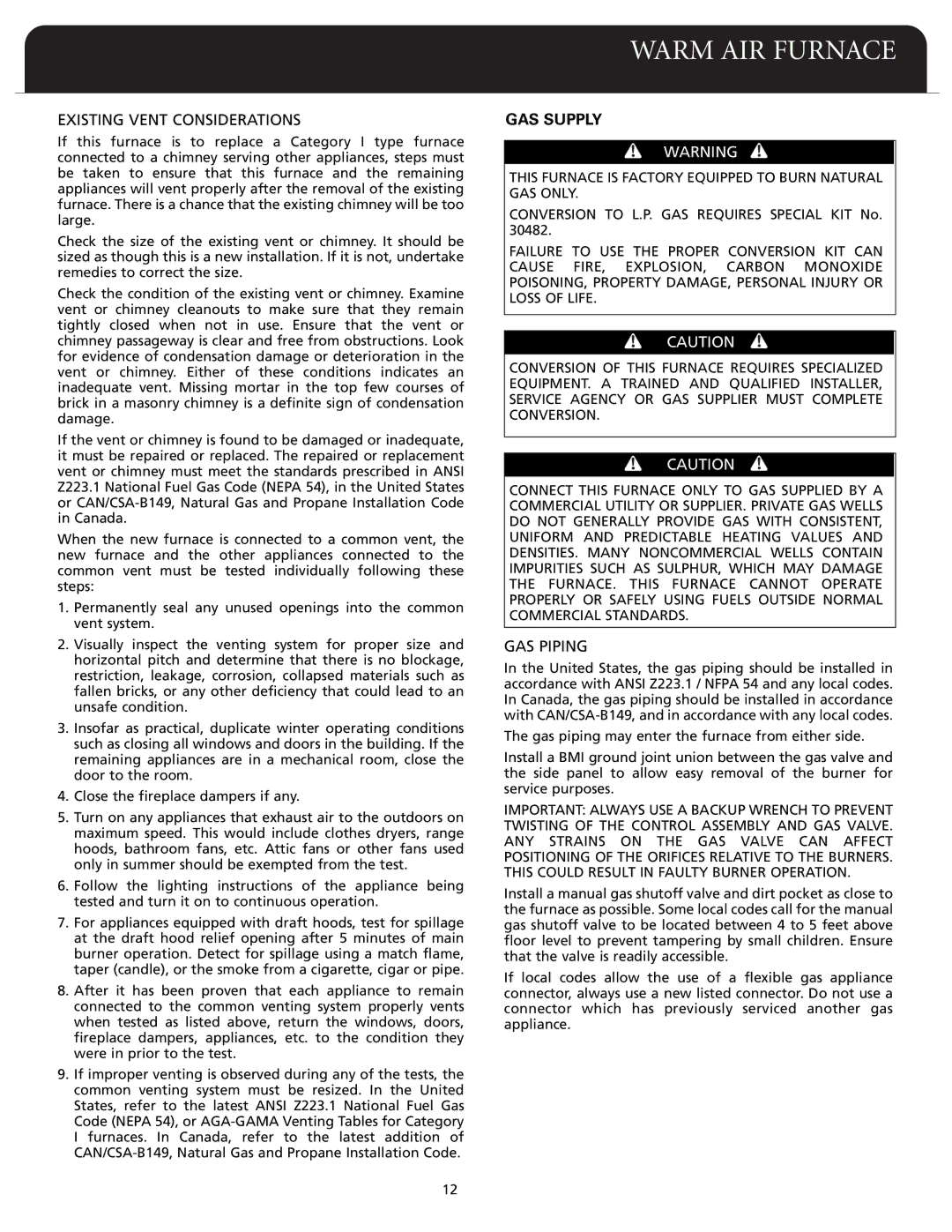EXISTING VENT CONSIDERATIONS
If this furnace is to replace a Category I type furnace connected to a chimney serving other appliances, steps must be taken to ensure that this furnace and the remaining appliances will vent properly after the removal of the existing furnace. There is a chance that the existing chimney will be too large.
Check the size of the existing vent or chimney. It should be sized as though this is a new installation. If it is not, undertake remedies to correct the size.
Check the condition of the existing vent or chimney. Examine vent or chimney cleanouts to make sure that they remain tightly closed when not in use. Ensure that the vent or chimney passageway is clear and free from obstructions. Look for evidence of condensation damage or deterioration in the vent or chimney. Either of these conditions indicates an inadequate vent. Missing mortar in the top few courses of brick in a masonry chimney is a definite sign of condensation damage.
If the vent or chimney is found to be damaged or inadequate, it must be repaired or replaced. The repaired or replacement vent or chimney must meet the standards prescribed in ANSI Z223.1 National Fuel Gas Code (NEPA 54), in the United States or CAN/CSA-B149, Natural Gas and Propane Installation Code in Canada.
When the new furnace is connected to a common vent, the new furnace and the other appliances connected to the common vent must be tested individually following these steps:
1.Permanently seal any unused openings into the common vent system.
2.Visually inspect the venting system for proper size and horizontal pitch and determine that there is no blockage, restriction, leakage, corrosion, collapsed materials such as fallen bricks, or any other deficiency that could lead to an unsafe condition.
3.Insofar as practical, duplicate winter operating conditions such as closing all windows and doors in the building. If the remaining appliances are in a mechanical room, close the door to the room.
4.Close the fireplace dampers if any.
5.Turn on any appliances that exhaust air to the outdoors on maximum speed. This would include clothes dryers, range hoods, bathroom fans, etc. Attic fans or other fans used only in summer should be exempted from the test.
6.Follow the lighting instructions of the appliance being tested and turn it on to continuous operation.
7.For appliances equipped with draft hoods, test for spillage at the draft hood relief opening after 5 minutes of main burner operation. Detect for spillage using a match flame, taper (candle), or the smoke from a cigarette, cigar or pipe.
8.After it has been proven that each appliance to remain connected to the common venting system properly vents when tested as listed above, return the windows, doors, fireplace dampers, appliances, etc. to the condition they were in prior to the test.
9.If improper venting is observed during any of the tests, the common venting system must be resized. In the United States, refer to the latest ANSI Z223.1 National Fuel Gas Code (NEPA 54), or AGA-GAMA Venting Tables for Category I furnaces. In Canada, refer to the latest addition of CAN/CSA-B149, Natural Gas and Propane Installation Code.
WARM AIR FURNACE
GAS SUPPLY
WARNING
THIS FURNACE IS FACTORY EQUIPPED TO BURN NATURAL GAS ONLY.
CONVERSION TO L.P. GAS REQUIRES SPECIAL KIT No. 30482.
FAILURE TO USE THE PROPER CONVERSION KIT CAN CAUSE FIRE, EXPLOSION, CARBON MONOXIDE POISONING, PROPERTY DAMAGE, PERSONAL INJURY OR LOSS OF LIFE.
CAUTION
CONVERSION OF THIS FURNACE REQUIRES SPECIALIZED EQUIPMENT. A TRAINED AND QUALIFIED INSTALLER, SERVICE AGENCY OR GAS SUPPLIER MUST COMPLETE CONVERSION.
CAUTION
CONNECT THIS FURNACE ONLY TO GAS SUPPLIED BY A COMMERCIAL UTILITY OR SUPPLIER. PRIVATE GAS WELLS DO NOT GENERALLY PROVIDE GAS WITH CONSISTENT, UNIFORM AND PREDICTABLE HEATING VALUES AND DENSITIES. MANY NONCOMMERCIAL WELLS CONTAIN IMPURITIES SUCH AS SULPHUR, WHICH MAY DAMAGE THE FURNACE. THIS FURNACE CANNOT OPERATE PROPERLY OR SAFELY USING FUELS OUTSIDE NORMAL COMMERCIAL STANDARDS.
GAS PIPING
In the United States, the gas piping should be installed in accordance with ANSI Z223.1 / NFPA 54 and any local codes. In Canada, the gas piping should be installed in accordance with CAN/CSA-B149, and in accordance with any local codes.
The gas piping may enter the furnace from either side.
Install a BMI ground joint union between the gas valve and the side panel to allow easy removal of the burner for service purposes.
IMPORTANT: ALWAYS USE A BACKUP WRENCH TO PREVENT TWISTING OF THE CONTROL ASSEMBLY AND GAS VALVE. ANY STRAINS ON THE GAS VALVE CAN AFFECT POSITIONING OF THE ORIFICES RELATIVE TO THE BURNERS. THIS COULD RESULT IN FAULTY BURNER OPERATION.
Install a manual gas shutoff valve and dirt pocket as close to the furnace as possible. Some local codes call for the manual gas shutoff valve to be located between 4 to 5 feet above floor level to prevent tampering by small children. Ensure that the valve is readily accessible.
If local codes allow the use of a flexible gas appliance connector, always use a new listed connector. Do not use a connector which has previously serviced another gas appliance.

